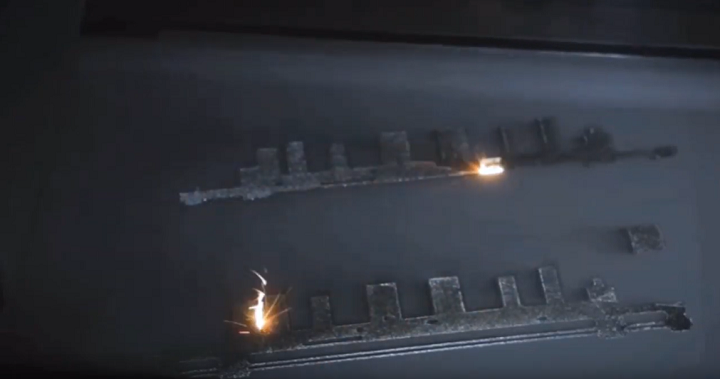“I feel the need…the need for speed!”
That iconic line was spoken by US Navy fighter pilots Maverick (Tom Cruise) and Goose (Anthony Edwards) in the 1986 action movie “Top Gun.” But how does this relate to 3D printing? Simple – the technology can help speed things up for businesses, which means more & faster profits. One way to speed up 3D printing is to deploy artificial intelligence or AI. 3D printing is a series of data-rich, Truth poor processes that generate nonstop data and intermittent parts of variable quality. Our lack of understanding, therefore, is the perfect playground for learning algorithms and analysis.
Brent Brunell, the Additive Technology Leader for GE Research, recently published a thought leadership post on LinkedIn, titled “AI, 3D Printing and the Need for Speed,” about some of the hardships and benefits of integrating AI into 3D printing processes.
“You might be wondering – what does the movie Top Gun have in common with 3D metal printers? Chiefly … the need for speed! One of the key challenges to fully utilizing AI to its greatest capability is getting higher computing power and speed,” Todd E. Alhart, Executive, Media Relations and Chief Technology Storyteller, GE Research, told 3DPrint.com.
“At GE, we’ve been combining our AI, Edge and Controls technical capabilities, together with our materials science and industrial domain knowledge to integrate AI effectively within our industrial products and processes … and into our 3D printers specifically.”
Recently, Brunell delivered the opening keynote address, together with VP for Software Research Colin Parris, at the AI Accelerator Summit in Boston. Speaking to an audience of, as Brunell puts it, “top hardware and chip innovators,” the two discussed this same topic of integrating AI into the company’s industrial applications and processes. They also mentioned that, in order to properly run apps enabled by AI in a large-scale industrial infrastructure, such as GE’s own metal 3D printers, higher computing speeds and computational power are necessary.
“To put this in perspective, just consider that printing one small metal fuel nozzle part that you can hold in your hand can generate 36 terabytes of data. That’s three times total amount of data Twitter generates in a day! And this data is not trivial,” Brunell wrote.
The data that needs to be analyzed and acted upon through 3D printing just that one small fuel nozzle part “represents layer-by-layer lessons in physics class,” which Brunell demonstrates in a video where he explains the many different factors that come into play through the fabrication of a part using a direct metal laser melting (DMLM) 3D printing process.
“You’ll get an appreciation too for just how fast the printing process is happening, as our AI algorithms account for all the factors we want to measure to ensure we get the first part right every time,” Brunell says about the video, in which he discusses the laser meltpool in the DMLM process and the many intricate data points that GE’s AI is capturing and interpreting.
First in the video, he showed the laser hitting the powder in real time, and then moved on to a simulation of the interaction between the laser and the powder bed. The simulation was run 1,000 times slower than real time to give viewers a really close look at the dynamics, and then run again at 20 times slower, two times slower, and finally in real time; the blue in this simulation is the powder bed metal.
“This simulation has convection, evaporation, melting, solidification, lots of the physics,” Brunell explains during the video.
The video simulation offers a great look at how DMLM works – you can see the depression made from the laser in the bottom layer of the bed, and how the part gradually solidifies after the laser has stopped moving.
“The thing to keep in mind is anything that’s moving quickly here, when you’re running the simulation a thousand times slower – imagine when you’re in real time, how quickly those move through,” he said in the video.
“The idea to capture is in that real time, all those dynamics are actually happening.”
You’ll get a better idea if you watch the video below – it’s really cool to see the slower simulation, listen to Brunell talk about all the different things that are going on, and then watch it a faster rate of speed, knowing that those same things are going on that quickly.
One of the goals of GE Research is to use AI to better understand, and control, the DMLM process, in order to get higher part yields, and one of the ways to do this is by achieving faster computing speeds.
“As you can see, we have built the brain using AI to measure the right parameters of a part build. All that’s needed now is the computing speed and computational power to process everything in real-time. Today, typical speeds can get as high as 2 kilohertz. To realize the maximum benefits of AI technology in an application like 3D printing, these speeds need to be much higher around 20 kilohertz,” Brunell concluded in his post.
Luckily, the company has plenty of connections with emerging venture startups and established hardware companies that share the same goal – increase speed.
Discuss this and other 3D printing topics at 3DPrintBoard.com or share your thoughts in the comments below.
Subscribe to Our Email Newsletter
Stay up-to-date on all the latest news from the 3D printing industry and receive information and offers from third party vendors.
You May Also Like
3D Printing Unpeeled: New Arkema Material for HP, Saddle and Macro MEMS
A new Arkema material for MJF is said to reduce costs per part by up to 25% and have an 85% reusability ratio. HP 3D HR PA 12 S has been...
3D Printing News Briefs, January 20, 2024: FDM, LPBF, Underwater 3D Printer, Racing, & More
We’re starting off with a process certification in today’s 3D Printing News Briefs, and then moving on to research about solute trapping, laser powder bed fusion, and then moving on...
3D Printing Webinar and Event Roundup: December 3, 2023
We’ve got plenty of events and webinars coming up for you this week! Quickparts is having a Manufacturing Roadshow, America Makes is holding a Member Town Hall, Stratafest makes two...
Formnext 2023 Day Three: Slam Dunk
I’m high—high on trade show. I’ve met numerous new faces and reconnected with old friends, creating an absolutely wonderful atmosphere. The excitement is palpable over several emerging developments. The high...



































